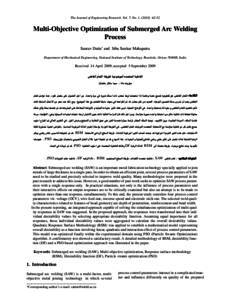Document
Multi-objective optimization of submerged arc welding process.
Contributors
Mahapatra, Siba Sankar, Author
Publisher
Sultan Qaboos University
Gregorian
2010
Language
English
Subject
English abstract
Submerged arc welding (SAW) is an important metal fabrication technology specially applied to join metals of large thickness in a single pass. In order to obtain an efficient joint, several process parameters of SAW need to be studied and precisely selected to improve weld quality. Many methodologies were proposed in the past research to address this issue. However, a good number of past work seeks to optimize SAW process parameters with a single response only. In practical situations, not only is the influence of process parameters and their interactive effects on output responses are to be critically examined but also an attempt is to be made to optimize more than one response, simultaneously. To this end, the present study considers four process control parameters viz. voltage (OCV), wire feed rate, traverse speed and electrode stick-out. The selected weld quality characteristics related to features of bead geometry are depth of penetration, reinforcement and bead width. In the present reporting, an integrated approach capable of solving the simultaneous optimization of multi-quality responses in SAW was suggested. In the proposed approach, the responses were transformed into their individual desirability values by selecting appropriate desirability function. Assuming equal importance for all responses, these individual desirability values were aggregated to calculate the overall desirability values. Quadratic Response Surface Methodology (RSM) was applied to establish a mathematical model representing overall desirability as a function involving linear, quadratic and interaction effect of process control parameters. This model was optimized finally within the experimental domain using PSO (Particle Swarm Optimization( algorithm. A confirmatory test showed a satisfactory result. A detailed methodology of RSM, desirability function (DF) and a PSO-based optimization approach was illustrated in the paper.
Member of
ISSN
1726-6742
Resource URL
Citation
Datta, S., & Mahapatra, S. S. (2010). Multi-objective optimization of submerged arc welding process. The Journal of Engineering Research, 7 (1), 42-52.
Arabic abstract
اللحام الغاطس هو تكنلوجيا تصنيع مهمة وخاصة إذا استعملت لربط معادن ذات أسماك كبيرة في مرة واحدة. من أجل الحصول على مفصل كفوء، عدة عوامل للحام الغاطس يجب أن تدرس بدقة لتحسين النوعية. العديد من نظم معادن قد تم اقتراحها في بحوث سابقة للتعامل مع هذا الموضوع. ومع ذلك عدد مهم من الأعمال السابقة كانت تأمل لتفعيل اللحام الغاطس ومفرداته باستجابة واحدة. في الأوضاع العملية، ليس فقط تأثير مفردات العملية وتأثيراتها المتفاعلة على المخرجات قد تم فحصها بدقة ولكن هناك محاولة لجعلها ذات فاعلية بأكثر من استجابة واحدة بصورة متزامنة. ومن أجل ذلك فإن الدراسة الحالية تأخذ بعين الاعتبار أربعة عمليات لمفردات السيطرة وهي : الفولتية، سرعة تغذية السلك، السرعة الجانبية، بروز الاكترود. نوعية السلك المختار ترتبط بمزايا هندسة الخرز هي عمق النفاذية والتسليح وعرض الخرز، في التقرير الحالي تم اقتراح أسلوب مدمج قابل كل ذو فاعلية متزامنة مع الاستجابة المتعددة النوعيات للحام الغاطس. في الطريقة الفردية بواسطة اختيار الدالة المرغوبة المناسبة. بافتراض أهمية متساوية لكافة الاستجابات، فإن هذه القيم الفردية المرغوبة قد جمعت لحساب القيم المرغوبة الشاملة. طريقة السطح الرباعي الاستجابة RSM قد تم تطبيقها لتأسيس نظام رياضي يمثل الرغبة الشاملة كدالة تشمل على تأثير خطي رباعي تفاعلي للعملية والمفردات. هذا النموذج قد تم تفعيلة أخيرا خلال الحقل التجريبي باستعمال خوارزميات PSO. فحوصات تأكيدية بينت نتائج مرضية. طريقة مفصلة إلى RSM الدالة الرغبة DF وكذلك الفاعلية المعتمدة على أسلوب الفاعلية PSO قد تم تبيانه في البحث.
Category
Journal articles

